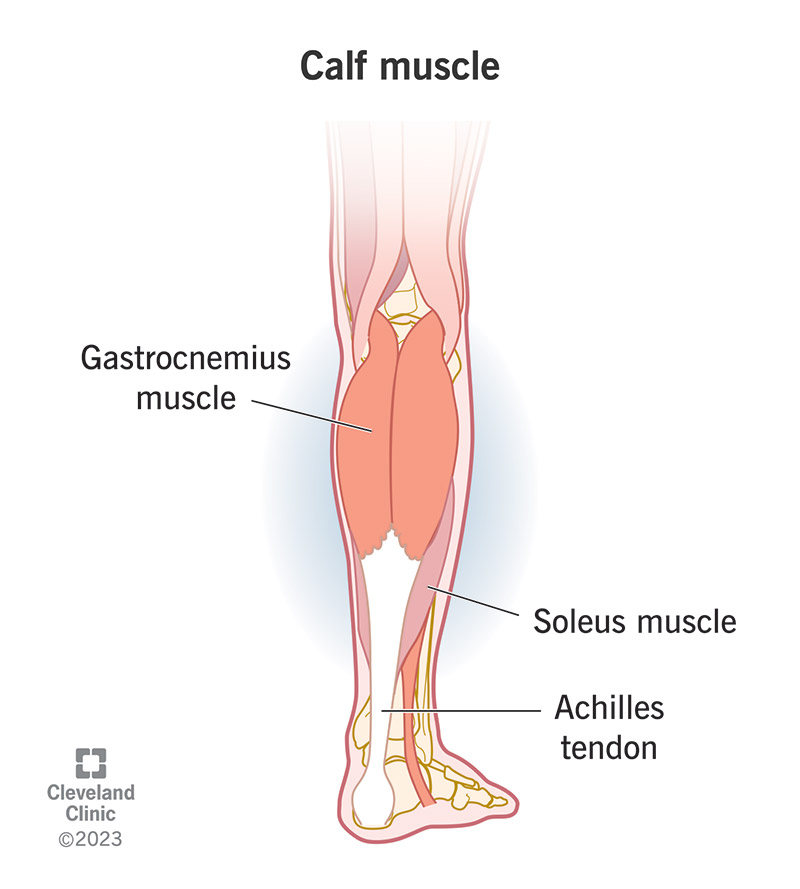Your calf muscle sits in the back of your lower leg. It starts below your knee and extends to your ankle. It allows you to walk, run, jump and flex your foot. It also helps you stand up straight. Strains and cramps are the most common conditions that affect your calf muscle.
Advertisement
Cleveland Clinic is a non-profit academic medical center. Advertising on our site helps support our mission. We do not endorse non-Cleveland Clinic products or services. Policy

Your calf muscle is in the back of your lower leg, behind your shin bone (tibia). It actually consists of three different muscles: your gastrocnemius, soleus and plantaris. Together, these lower leg muscles help you walk, run, jump, stand on your toes and flex your foot (push your toes down toward the ground).
Advertisement
Cleveland Clinic is a non-profit academic medical center. Advertising on our site helps support our mission. We do not endorse non-Cleveland Clinic products or services. Policy
Your calf muscle supports you when you stand and enables you to move your foot and your lower leg. It propels (pushes) you forward when you walk or run. It also allows you to jump, rotate your ankle, flex your foot and “lock” your knee.
Your calf muscle is in the posterior — meaning the back part — of your lower leg.
Your calf muscle consists of two main muscles — your gastrocnemius and soleus. Because these two muscles come together above your heel and form your Achilles tendon, some providers refer to the gastrocnemius and soleus as one large muscle with two sections.
Your gastrocnemius muscle is just under your skin at the back of your lower leg. Because your gastrocnemius is close to your skin’s surface, you can often see its outline. It forms the bulk of your calf muscle.
The top part of your gastrocnemius has two heads that start on the inside and the outside of your thighbone (femur). Your gastrocnemius goes down the back of your leg and attaches to your Achilles tendon. Gastrocnemius strains are common because the muscle connects to two joints (your knee joint and your ankle joint).
Your soleus muscle is wide and flat and sits slightly deeper than your gastrocnemius muscle. It starts just below your knee, runs down your lower leg and connects to your Achilles tendon above your heel. Soleus injuries are less common because the muscle only crosses your ankle joint.
Advertisement
Your soleus connects to your tibia and fibula (the bones in your lower leg). Together with your gastrocnemius, your soleus helps you walk, run and jump. It also helps your legs support you so you can maintain good posture.
In addition to these two large muscles, a small muscle called the plantaris runs between your gastrocnemius and soleus down the length of your lower leg. Providers call these three muscles the triceps surae. But not everyone has a plantaris muscle. About 10% of people only have the two larger muscles.
As part of your musculoskeletal system, your gastrocnemius and soleus are skeletal muscles. Many individual fibers make up skeletal muscles. These fibers bundle together to create a striated (striped) appearance.
Many conditions and disorders can affect your calf muscle. These include:
Calf muscle strain is one of the most common muscle strain injuries among athletes. People who play sports that require sprinting and quick footwork have an increased risk of this type of injury.
Leg cramps are also very common, and they’re more likely to happen as you age. Providers estimate that about 75% of people over the age of 50 have had leg cramps at some point.
Problems in your calf muscles can cause:
To avoid problems with your calf muscle, you should:
Advertisement
If you have severe or sudden calf pain that doesn’t improve after a day or two of rest, call your provider. Calf pain and other symptoms of a muscle strain may be signs of a serious medical condition, like a blood clot, deep vein thrombosis (DVT), nerve damage or Achilles tendonitis.
Get help right away if you have:
Your calf muscle helps you move your lower legs, feet and ankles. It allows you to flex your feet, walk, run and leap. It also supports and stabilizes your legs and enables you to stand up straight. Calf pain from muscle strains and leg cramps is very common. You can keep your calf muscles strong by staying active, drinking plenty of water and warming up before you exercise. Call your provider if you have calf tenderness that doesn’t get better in a day or two — or if you have swelling, discoloration or severe pain.
Advertisement
Cleveland Clinic’s primary care providers offer lifelong medical care. From sinus infections and high blood pressure to preventive screening, we’re here for you.

Last reviewed on 12/18/2023.
Learn more about the Health Library and our editorial process.